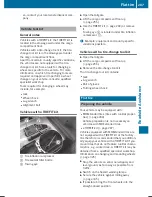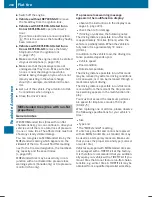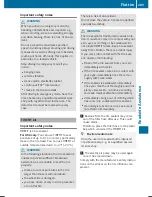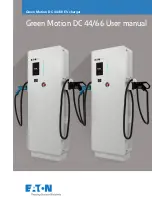
Tire pressure not reached
If a pressure of 180 kPa (1.8 bar/26 psi) has
not been attained after five minutes:
X
Switch off the tire inflation compressor.
X
Unscrew the filler hose from the valve of the
faulty tire.
Note that tire sealant may escape when you
unscrew the filler hose.
X
USA only: very slowly drive the vehicle for-
wards or reverse approximately 30 ft
(10 m).
X
Pump up the tire again.
After a maximum of five minutes the tire
pressure must be at least 180 kPa (1.8 bar/
26 psi).
G
WARNING
If the required tire pressure is not reached
after the specified time, the tire is too badly
damaged. The tire sealant cannot repair the
tire in this instance. Damaged tires and a
tire pressure that is too low can significantly
impair the vehicle's braking and driving
characteristics. There is a risk of accident.
Do not continue driving. Contact a qualified
specialist workshop.
Tire pressure reached
G
WARNING
A tire temporarily sealed with tire sealant
impairs the vehicle's driving characteristics
and is not suitable for driving at higher
speeds. There is a risk of an accident.
Adapt your driving style accordingly and
drive carefully. Do not exceed the maximum
permissible speed for a tire sealed with tire
sealant.
USA only: The maximum permissible speed
for a tire sealed with tire sealant is 50 mph
(80 km/h). The upper part of the TIREFIT
sticker must be affixed to the instrument clus-
ter in the driver's field of vision.
If a tire pressure of 180 kPa (1.8 bar/26 psi)
has been attained after five minutes:
X
Switch off the tire inflation compressor.
X
Unscrew the filler hose from the valve of the
faulty tire.
Note that tire sealant may escape when you
unscrew the filler hose.
X
USA only: Stow the tire sealant bottle and
the tire inflation compressor.
X
Pull away immediately.
X
Stop after driving for approximately ten
minutes and check the tire pressure with
the tire inflation compressor.
The tire pressure must now be at least
130 kPa (1.3 bar/19 psi).
G
WARNING
If the required tire pressure is not reached
after driving for a short period, the tire is too
badly damaged. The tire sealant cannot
repair the tire in this instance. Damaged
tires and a tire pressure that is too low can
significantly impair the vehicle's braking and
driving characteristics. There is a risk of
accident.
Do not continue driving. Contact a qualified
specialist workshop.
i
USA only: In cases such as the one men-
tioned above, contact an authorized
Mercedes-Benz Center. Or call
1-800-FOR-MERCedes (in the USA) or
1-800-387-0100 (in Canada).
X
USA only: Correct the tire pressure if it is
still at least 130 kPa (1.3 bar/19 psi). See
the Tire and Loading Information placard on
the driver's side B-pillar or the tire pressure
table in the fuel filler flap for values.
X
To increase the tire pressure: switch on
the tire inflation compressor.
Flat tire
291
Roads
ide
As
si
stan
ce
Z
















































